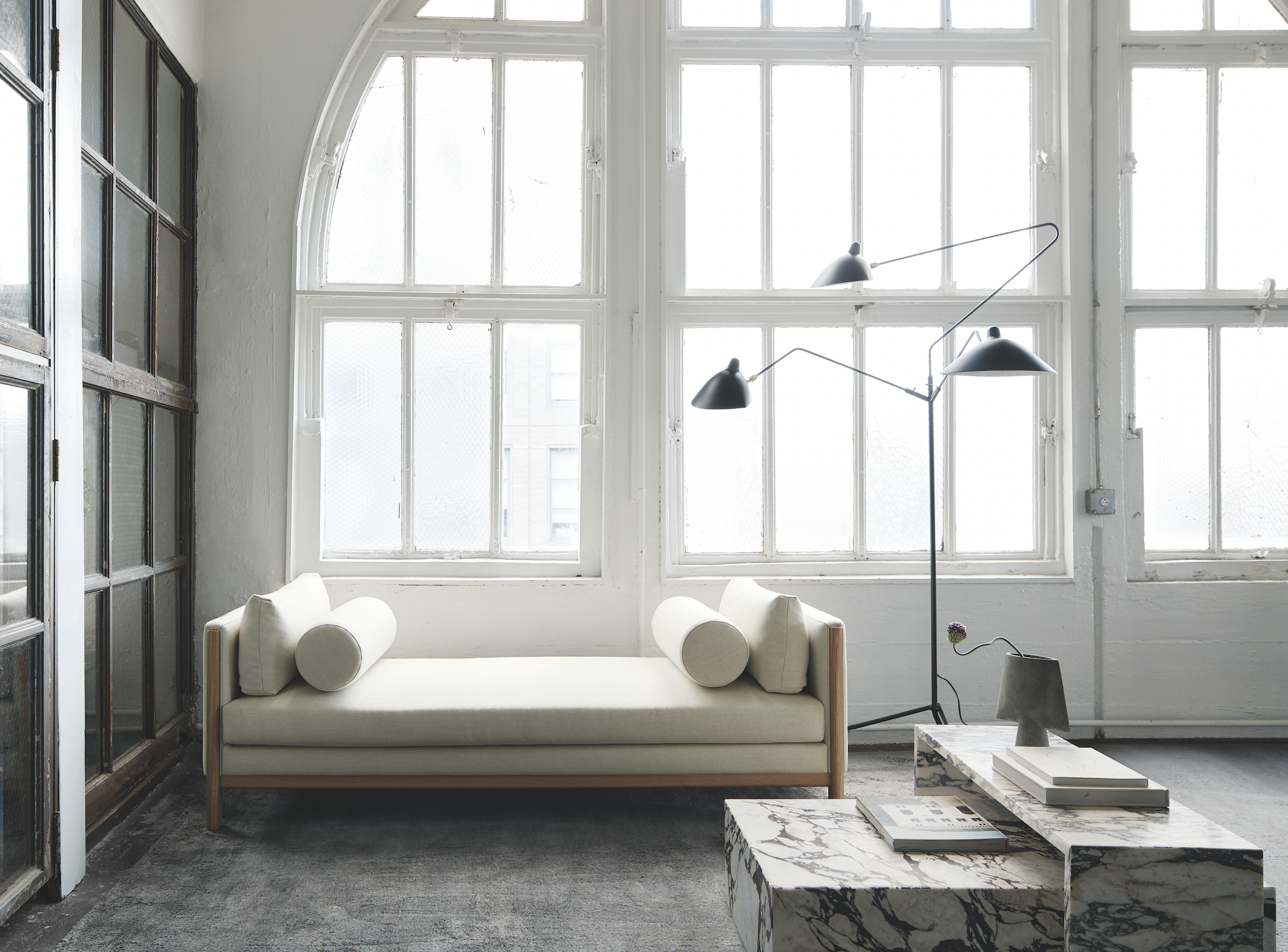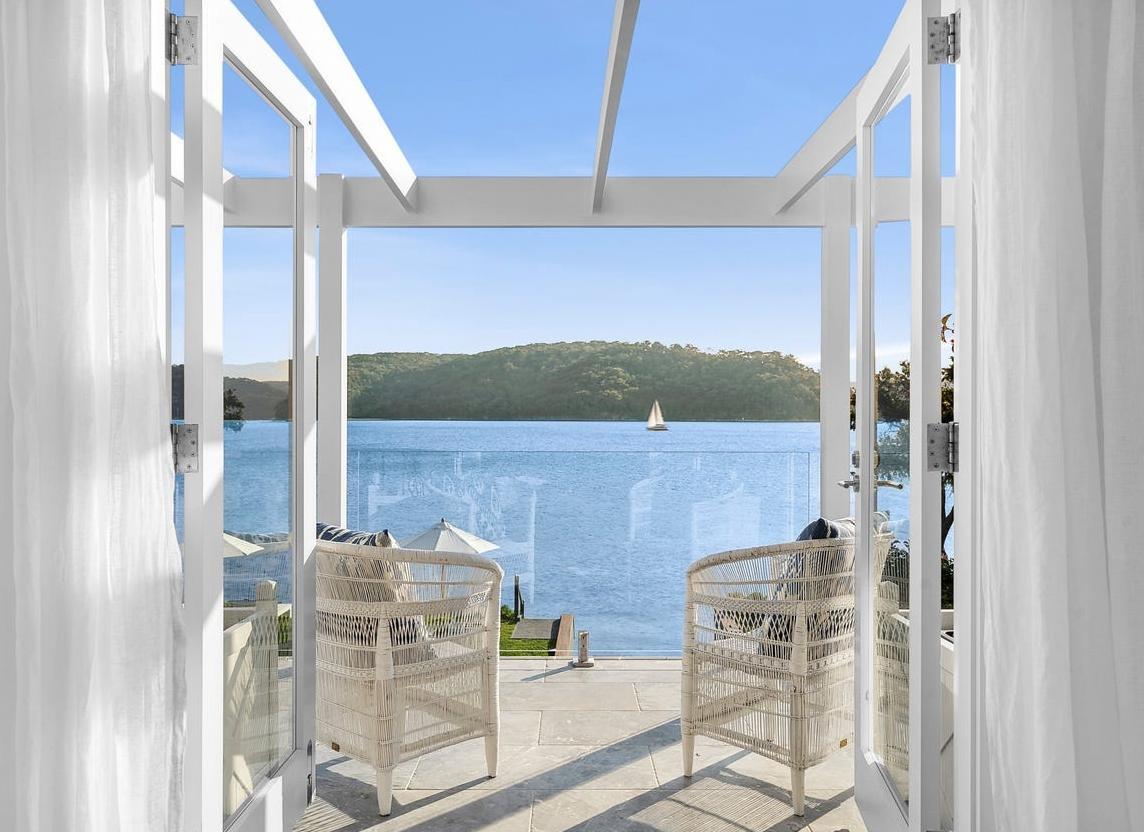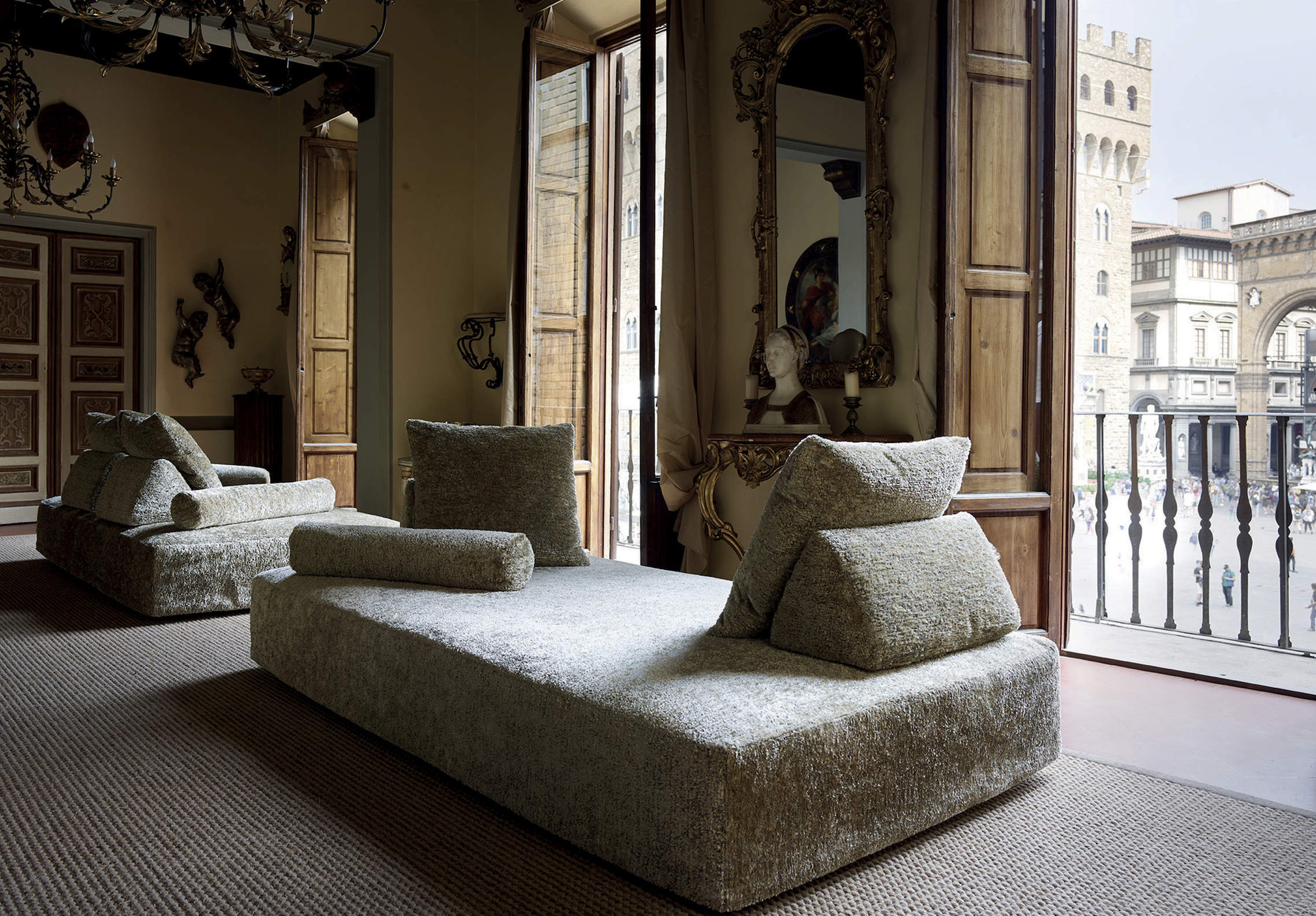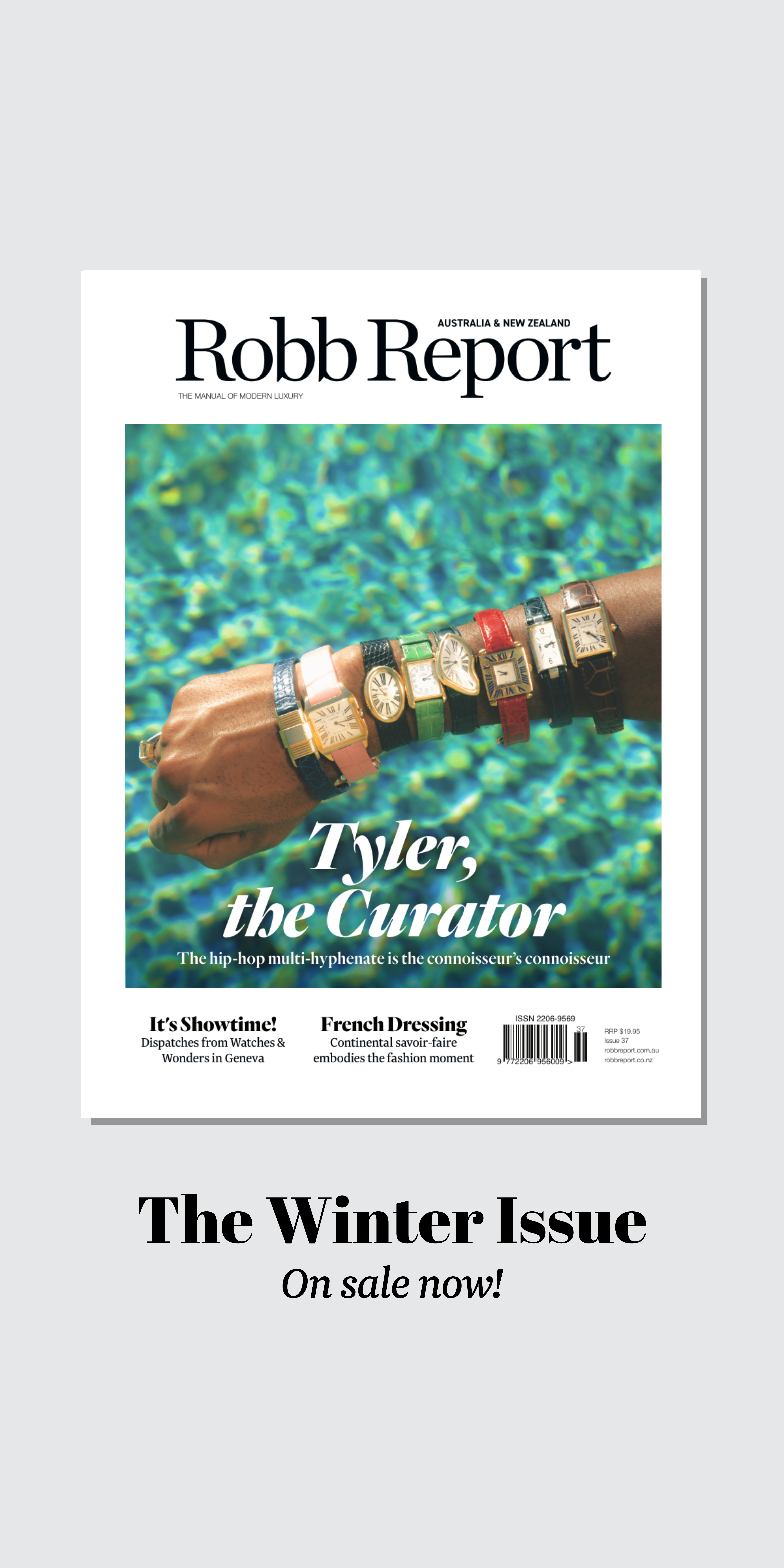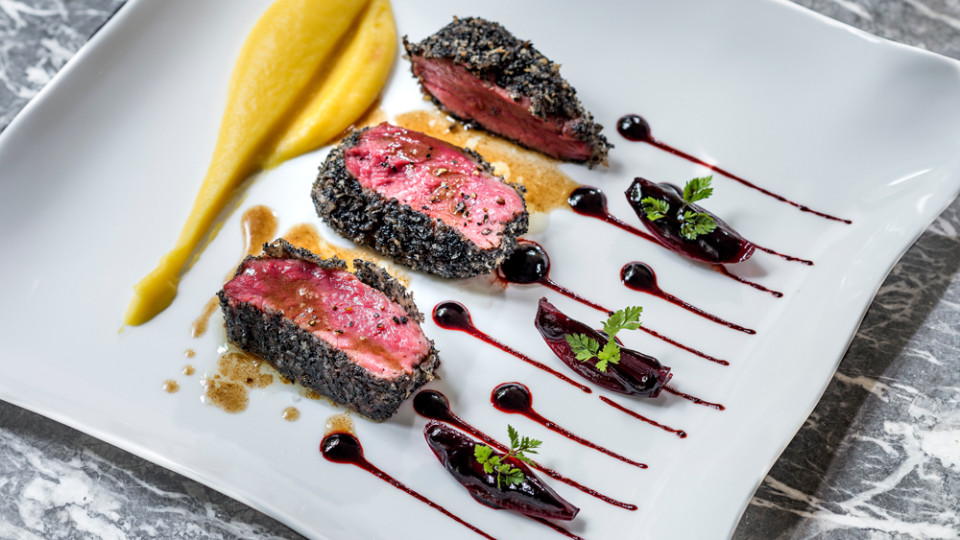
Here are the 27 restaurants in France rated three stars by Michelin
In the little red guide’s home country, these are the establishments it deems to have “exceptional cuisine that is worth a special journey.”
Related articles
Michelin has almost become as emblematic of the French fine-dining landscape as the cuisine itself. While today we may think of the guidebook as a comprehensive tastemaker, the Michelin Guide’s goal in 1900 when it launched was much simpler: to drive local tourism.
At a time when there were fewer than 3,000 automobiles in all of France, the Michelin Guide was designed to highlight hotels and restaurants in such a way that would encourage motorists to make the trek- presumably wearing out their tires in the process. In 1926 the guidebook began awarding stars, and by 1936, Michelin had adopted its criteria for the tiered ratings. One star indicates a “very good restaurant in its category,” two stars translate to”excellent cooking, worth a detour,” while the coveted three stars mean a restaurant offers “exceptional cuisine, worth a special journey.
Today, with 27 restaurants achieving Michelin’s top honor, France has more three-Michelin star restaurants of any country in Europe (globally, it trails only Japan, which has 34 three-star restaurants). And because Michelin inspectors have been weighing in on French restaurants longer than anywhere else, many of the country’s honorees have been holding onto their star-rating for decades. From Alain Ducasse to Régis et Jacques Marcon, here are France’s 27 Michelin three-star restaurants.
Alain Ducasse au Plaza Athénée, Paris, 8th Arrondissement
“Fresh-picked” can be taken literally at Alain Ducasse’s Plaza Athénée, where everything from the Bonnotte potatoes to the baby fava beans are grown exclusively for guests and harvested the morning of diners’ meals. In 2014 the restaurant temporarily closed to shift its focus to all things eco-friendly under the leadership of executive chef Romain Meder. Initially upon reopening in 2015, Alain Ducasse au Plaza Athénée was demoted to two Michelin stars, only to quickly climb back to three in 2016. The restaurant’s natural-focused ethos extends from its pesticide-free produce to its simple preparation techniques and “fish-vegetables-cereal trilogy” philosophy which, Ducasse asserts, promotes a diet more in tune with nature and better for health. You’ll find traditional French fare on the menu, as well as dishes inspired by 7th century buddhist-influenced Shojin cuisine.

That’s a lot of Swarovski crystal.
Courtesy of Pierre Monetta/Alain Ducasse au Plaza Athénée
Alléno Pavillon Ledoyen, Paris, 8th Arrondissement
Pavillon Ledoyen’s deep Parisian roots date back to 1842, when the restaurant was first erected in the Champs-Elysées’ gardens. While you can catch a glimpse of the original painted moldings and ceiling in the upstairs dining room, chef Yannick Alléno, who took over in 2014, brings a modern sensibility to the historic site, which earned the spot a third Michelin star just seven months after he started. Alléno’s pet technique for making sauces involves “extractions”. This entails first extracting liquids from ingredients and then reducing them using a technique called cryoconcentration, which involves a combination of sub-zero temperatures and centrifugal force. Diners can enjoy the fruits of this methods in dishes like a dessert that features a coffee-flavored fir-tree extraction jelly.

Langoustines cuites au naturel bouillon.
Courtesy Philippe Vaures
Arpège, Paris, 7th Arrondissement
Today, there are few chefs quite as influential as Alain Passard, but back in 1986 he was simply trying to fill his mentor Alain Senderens’ big shoes. That’s the year Passard took over Senderens’ restaurant Archestrate. Passard renamed his new venture Arpège, the French word for arpeggio, a name that like the establishment’s original name (which means orchestra en francais) pays tribute to his second love: music. Before arriving at Arpège, Passard cut his teeth at the Duc d’Enghien at the Casino of Enghien and the Carlton in Brussels, where he was awarded his first Michelin stars. Arpège earned its third in 1996 and has held onto them ever since—even after adopting a plant-centric menu in 2001. Guests can sample the signature dishes that put Passard on the map, such as his famous l’arpège egg—the hot-cold, hard-soft boiled amuse bouche you’ll now find tributes to at fine-dining restaurants around the globe, maybe most notably at David Kinch’s Manresa.

Astrance, Paris, 16th Arrondissement
Astrance’s mere 24 seats makes it one of the toughest reservations in town. Before working in renowned restaurants (including a five-year stint in Passard’s Arpège), chef Pascal Barbot spent a year in the navy, where he cooked in destinations as far-flung as Tonga and Fiji. Barbot then opened Astrance and won his first Michelin star before his 28th birthday, and went on to earn his second star in 2005 and his third in 2007. Today the menu at Astrance is always a surprise, but Barbot describes his style as a marriage between the techniques and flavours he finds abroad and classic French cuisine.

Aioli Moderne, Légumes de nos Maraîchers du Beausset, Poulpe de pêche locale
Anne-Emmanuelle Thion
Christophe Bacquié, Le Castellet
A new inductee into Michelin’s three-star club in 2018, the eponymous Christophe Bacquié at the Castellet Hotel has been praised for its modern Mediterranean-influenced cuisine that puts local produce front-and-centre. His specialty is le poisson, which he credits to working closely with fishermen in Corsica, where he learned the intricacies of preparing local fish species. “A real ode to the produce found in his region, Christophe Bacquié now offers very high-flying cuisine: vibrant with emotions,” says Michael Ellis, the Michelin guide’s former director. “Each dish creates a memory; a testimony to his creative talent, his perfect technical skills and maturity.” Chef Bacquié previously earned two stars at Calvi in 2007 and Hôtel du Castellet in 2010 after just two months at its helm.

The cuisine of Christophe Bacquié.
Courtesy Anne-Emmanuel Thion
Epicure, Paris, 8th Arrondissement
While many Michelin-star-winning chefs could be considered culinary royalty, Epicure’s chef Eric Frechon bears an additional, extra-official-sounding honorarium. He was decorated as a Knight of the Order of the “Légion d’Honneur” by Nicolas Sarkozy in 2008—just a year before he was first awarded three Michelin stars. The self-described “control freak” prides himself on his ability to elevate simple—even cheap—ingredients into Michelin-star-worthy fare. Though, there’s no shortage of decadence on his menu. You’ll find classic French cuisine, such as whole roast chicken cooked in a pig’s bladder (a signature dish) and black truffle, artichoke and foie-gras stuffed macaroni.

Flocons de Sel, Megève
Nestled in the French Alps, Flocons de Sel offers a taste of the mountains. Chef Emmanuel Renaut scours the hillsides for herbs and mushrooms to adds to his dishes. He also takes a twice-yearly sojourn with award-winning cheesemaker Jacques Dubouloz through local farms and pastures in pursuit of the very best cheese. Just don’t expect to see fussily prepared cheese dishes at Folcons de Sel: When it comes to le fromage, Renaut is a purist. You’ll find all 20 of the menu’s hand-selected cheeses in their natural state. “I don’t like to cook with cheeses. I think it’s a waste,” he once remarked.

The cuisine of Emmanuel Renaut. Courtesy Anne-Emmanuelle Thion.
Georges Blanc, Vonnas
Going on 38 straight years of three Michelin stars, Georges Blanc—both the chef and the restaurant—is a French culinary fixture. While Blanc sharpened his technique in restaurants in France and abroad (as well as during a stint as a military cook) it’s hard not to think that some of his talent might be hereditary. Three generations of cooks preceded him, including his grandmother, who was once named the “best cook in the world”, by a food writer. Blanc took the reins from his mother in 1968, before turning the family business into a luxury hotel in the ‘70s.

The cuisine of Georges Blanc. Courtesy Emmanuel Nguyen
Guy Savoy, Paris, 6th Arrondissement
Guy Savoy is almost as much a French institution as the iconic sites that surround it (namely, the Louvre, Pont Neuf and the Seine). Savoy’s signature style, which he perfected in the kitchen of the legendary Maison Troisgros, blends a reverence for the natural attributes of his ingredients, mastery of technique, and a dash of bold creativity, which you can taste in signature dishes, such as his artichoke soup with black truffle, ice poached oysters, and ‘open’ mille-feuille. In addition to holding onto his three stars since 2002, Guy Savoy has opened a number of lauded satellite restaurants, including a stateside version of Guy Savoy located in Vegas’s Caesars Palace.

The cuisine of Guy Savoy. Courtesy Laurence Mouton.
L’Ambroisie, Paris, 4th Arrondissement
Abandoned by his parents and placed in an orphanage at 13, chef Bernard Pacaud found salvation in the kitchen of Eugénie Braizer’s Col de la Luère. The three-star-winning Lyonnais chef took Pacaud under her wing, providing him with both a roof over his head and a place to learn the craft. First nabbing his own third star in 1988, Pacaud has been holding onto the stellar Michelin rating for longer than any of Paris’s other three-star restaurants. L’Ambroisie lives up to its name- which means “food of the gods”- with its lavish, stunningly plated dishes like sea bass and artichoke served atop caviar. And even if the gods don’t literally dine there, some pretty powerful mortals do: In 2015 presidents Barack Obama and Francois Hollande enjoyed a working dinner at L’Ambroisie.
L’Assiette Champenoise, Tinqueux
Chef Arnaud Lallement’s fate as a chef seems predestined. As a child, he watched his father Jean-Pierre, who ran the family restaurant starting in 1975. Then, after studying under culinary legends like Roger Vergé and Michel Guérard, Lallement took over at the helm in 1998. There, he won L’Assiete its second Michelin star in 2005 and its third in 2014. The menu boasts classic dishes (such as grated foie gras served over fois gras toast), as well as unique novel ones (milk-fed veal sweetbreads), but always with a focus on bringing out the pure flavours of the ingredients with just the right balance of acidity (Lallement’s mantra is “mangez vrais,” which translates to, “eat true”). And, as you’d expect from the region, there are more than a thousand champagnes in the cellar for you to sip with your meal.

Chef of the Century.
Image: courtesy Paul Bocuse/Facebook
L’Auberge du Pont de Collonges (aka Paul Bocuse), Collonges-au-Mont-d’Or
When you step into L’Auberge du Pont, you’re setting foot on hallowed grounds, thanks to the legacy of “the pope of gastronomes”, Paul Bocuse, which continues to loom large, even after the chef’s death in January 2018. Bocuse has been credited with introducing nouvelle cuisine—trading the heavier elements of traditional French cooking for lighter, fresher ingredients and deliberately artful plating—and changing the face of fine-dining forever. Bocuse took over the family-run restaurant in 1956, after honing his skills at La Pyramide. Two years later, he earned his first Michelin star in 1958, and was elevated to a second in 1960 and a third in 1965. Today, a trio of chefs, Christophe Muller, Gilles Reinhardt and Olivier Couvin, carry on Bocuse’s legacy at the flagship restaurant, where you’ll still be able to enjoy his quintessential dishes, like sea bass in puff pastry shell and black truffle soup.

Outside Paul Bocuse’s restaurant. Courtesy L’Auberge du Pont de Collonges.
L’Auberge du Vieux Puits, Fontjoncouse
Chef Gilles Goujon’s rise to Michelin stardom is the stuff of heartwarming movies. In 1990, he bought L’Auberge de Vieux Puits in the small village of Fontjoncouse for 34,000 Euro afterits previous three owners had failed to turn a profit. For five years he struggled to attract diners. But his fortune turned in 1996 when he won the “Best Worker of France,” a prestigious award given out every four years to artisans in different categories. Shortly after, he snagged his first Michelin star in 1997. He won his second star in 2001 and his third in 2010.

Chocolate Soufflé.
Courtesy L’Auberge du Pont de Collonges
La Bouitte, Saint Martin, Saint Martin de Belleville
René and Maxime Meilleur, the self-taught, father-son chef duo behind La Boutte, have been cooking together since 1996. The pair’s cuisine pays tribute to the surrounding Savoie region, with ingredients like crozet pasta, raclette and Saint Martin goat’s milk, and first earned its third star in 2015. “The dishes are precise, generous and remarkably creative. “La bouitte” may mean small house in the local dialect, but the fare offered by René, Maxime and their spouses is of the highest calibre,” Ellis said when awarding La Bouitte it’s third star.
La Maison des Bois, Manigod
Identifying primarily as a peasant, chef Marc Veryat is committed to showcasing wild botanicals and other pastoral gems from the region—with a few molecular gastronomic flourishes. On his nature-meets-science menu, you may see dishes like trout cooked in a spruce bark butter-style sauce (sans actual butter). “As a passionate botanist, Marc Veyrat enhances the Savoyard herbs and flowers he gathers from the wild, and combines creativity, authenticity and refinement to offer customers an unforgettable experience,” the guide’s director said.

Oyster with sushi rice.
Courtesy of Lucie Cipolla/Netflix
La Maison Troisgros, Ouches
Holding onto its three-star rating for half a century, La Maison Troisgros—and the family dynasty behind it—has long been a driving force in French cuisine. In 1930 Jean-Baptiste Troisgros opened the restaurant near Lyon. Later, his sons Jean and Pierre took the reins, shaping it into the triple-starred establishment it is today with their nouvelle cuisine. Now Pierre’s son Michel runs the empire, alongside his wife Marie-Pierre and son César. César credits the restaurant’s continued success to his mother’s intuition (she’s pioneered much of Troisgros’s growth) and his father’s culinary sensibilities, which César describes as “tangy, vibrant, fresh, and measured”. Meanwhile, as the youngest Troisgros, César brings youthful perspective, flavors inspired by his travels through Spain and California (he also worked at Thomas Keller’s French Laundry), and “a thing for hot peppers”. The dish he says most encapsulates the restaurant’s ethos today is the cosa croquante: a salad made with shaved carrots that have been lightly fried and seasoned with herbs from the family garden.

cuisine of Marc Veryat.
Courtesy Richard Haughton.
La Vague d’Or, Saint-Tropez
Arnaud Doncklele’s impressive resume includes apprenticeships in the kitchens of Alain Ducasse and Michel Guérard, so it’s hardly a surprise that the young chef achieved three Michelin Stars by the time he turned 35. La Vague D’Or offers three tasting menus, including the seven-course “Balade Epicurienne” for adventurous diners and a five course vegetarian option. There’s also two à la carte menus: one inspired by land and one inspired by the sea—which happens to be within view of restaurant’s umbrella-lined terrace, by the way.

Courtesy Richard Haughton
Le 1947 at Cheval Blanc, Courchevel
Yannick Alléno has performed the chef’s equivalent of a hat trick, having earned three triple-star Michelin restaurants over the course of his career. Ten years after his three-star win at Le Meurice, and three years after earning three stars at Pavillon Ledoyen, Michelin awarded him stars for Le 1947 at Cheval Blanc in 2017. The Alpine outpost’s sleek, modern surroundings—which include a perforated sphere through which diners can watch the chefs work—set the tone for the nine-course menu that puts a creative spin on French cuisine. Le 1947 is named after Château Cheval Blanc’s most renowned vintage and aims to provide guests with an experience just as covetable.

Le Cinq, Paris, 8th Arrondissement
From within the Four Seasons Hotel George V, chef Christian le Squer combines nostalgic French flavours with ambitious new techniques. “My cooking is like a Chanel suit worn over a pair of jeans,” he once said. You can taste this amalgam in dishes like his Parisian-style gratinated onions or line-fished sea bass served with caviar and buttermilk (a nod to growing up near the Morbihan sea in Brittany). “His signature is all over the superb dishes, mastered to perfection and demonstrating exceptional skills and a deep knowledge of the very best produce,” Ellis said when the 2016 Michelin Guide was released. “Each of Christian Le Squer’s dishes is a true work of art, a shining example of the best of French gastronomy.” Prior to racking up stars at Le Cinq in 2016, Le Squer enjoyed 12 consecutive years of three-star glory at Pavilion Ledoyen.
Alain Ducasse à l’Hôtel de Paris (formerly known as Le Louis XV), Monte Carlo
The first hotel restaurant to secure three Michelin stars, Alain Ducasse’s Le Louis XV has become as much a fixture in Monte Carlo as any casino. But the Riviera mainstay has undergone changes in recent years. In 2007 Franck Cerutti assumed the role of executive chef and was joined by Ducasse’s protege, Dominique Lory, in 2011. Then, the space underwent a more physical transformation in 2015, trading its opulent, 19th-century-inspired wall hangings and sculptures for a more modern vision of luxury. Along with it, the menu got a little facelift, moving to even lighter, more nuanced fare. “Creating a menu is like writing good music,” Ducasse told The New York Times. “Loud and strong contrasts with soft and gentle. In a world where people zap away from anything they don’t instantly love or understand, gastronomic luxury happens when a dish is so well conceived it wins the time to seduce with subtlety.”

Le Petit Nice, Marseille
Chef Gérald Passédat says he inherited his taste for beauty and appreciation for things well done from his family of artists and chefs, while he honed his technique in the kitchens of the Troisgros brothers and Michel Guérard. It all came together in 2008 when Le Petit Nice first ascended to three stars. Passédat’s cuisine leans heavily on the abundance of fish in the sea the restaurant overlooks. In a year, he estimates at least 65 different Mediterranean species make their way onto his plates. An updated take on classic bouillabaisse, anemone fritters, seafood carpaccio and a delicately prepared sea bass named for the chef’s opera star grandmother are a few of the signature dishes that grace Passédat’s menu.

Le Pré Catelan, Paris, 16th Arrondissement
In one respect Frédéric Anton, one of France’s most admired chefs, is an utter failure: As a child he aspired to become a cabinetmaker. Alas, his cabinet-making dreams were put on hold when he began his career as a chef in 1983, and further left in the dust when he proceeded to cook under some of fine-dining’s biggest names—including serving as Joël Robuchon’s chef de cuisine. Anton’s impressive pedigree eventually landed him at Le Pré Catelan in 1997, where he earned two Michelin stars by 1999 and was elevated to a third in 2007.

The cuisine of Michel Guérard. Courtesy Yoan Chevojon.
Les Prés d’Eugénie – Michel Guérard, Eugénie des Bains
If one were to erect a Mount Rushmore of French gastronomy, Michel Guérard’s inclusion would be a foregone conclusion. One of the so-called founding fathers of French nouvelle cuisine, Guérard got his first taste of Michelin stardom at Pot-au-Feu, which won its second star in 1971. He opened Le Prés d’Eugénie in 1974, and his cuisine was awarded its first star almost immediately, with a second star arriving in 1975 and a third following in 1977. Today, he’s focused on balancing the hedonistic delights of food with healthy eating.
Maison Lameloise, Chagny
This Burgundian restaurant has been a gastronomic institution since Michelin’s inception. It appeared in Michelin’s very first guide in 1900 and earned its first star in 1926. Maison Lameloise enjoyed its first three-star streak between 1979 and 2004, which picked back up again in 2007. Many of the restaurant’s most successful years occurred under Jacques Lameloise, who took over from his father in 1979. In 2008, Lameloise passed the torch to then up-and-comer Eric Pras, who has kept its three-star rating going strong ever since. Pras has made his mark on the mainstay’s menu with technically precise dishes that put a fresh spin on Burgundian cuisine.

Pic, Valence
Pic’s Michelin-star-studded history dates back to the early 20th century. Andre Pic opened in Valence in 1935 and earned three Michelin stars by 1939. Later years proved to be rockier, with the restaurant dropping to two stars in 1946 and to one in 1950. Under the leadership Andre’s son Jacques, Pic ascended again to two stars in 1959 and three in 1973, before falling back to two in 1995, just a few years after Jacques’ death. Then, Jacques’s daughter, Anne-Sophie, took over the illustrious dining spot in 1998 with no formal training. Less than a decade later, chef Pic, the only woman in France with three Michelin stars (and just the fourth woman ever to receive the honour), restored Pic to three-star glory in 2007. She describes her cuisine as simple, sophisticated and pointedly feminine, which you’ll see reflected in the menu, as well in the decor. “All my emotions are feminine, so I have this feminine way in my cooking. I think some men are able to make very feminine cuisine, but they are perhaps more focused on technique, less on developing the emotional part,” she told CNN in 2012.
Pierre Gagnaire, Paris, 8th Arrondissement
Credited with pioneering the French fusion movement, Pierre Gagnaire’s philosophy in the kitchen is, “tourné vers demain mais soucieux d’hier”—or “facing tomorrow, but respectful of yesterday”. His own culinary past is a mix of formal training and familial connections. Pierre Gagnaire learned the ropes from his Michelin-star-winning chef father, as well as in the kitchens of the highest calibre French chefs of the era, including Paul Bocuse. Gaugnaire took these lessons and started his own restaurant in his hometown of Saint Etienne in 1980, which received three Michelin stars in 1993, but struggled financially. Then, in 1996, Gagnaire opened his eponymous establishment. By 1998 he had his three Michelin stars again.

The cuisine of Pierre Gagnaire. Courtesy Francois Flohic.
Régis et Jacques Marcon, Saint Bonnet le Froid
Named after the father-son team that runs the restaurant, Régis et Jacques Marcon offers a seasonal taste of the Haute-Loire region—with a special reverence for the local mushrooms (Régis has even written a book on his beloved champignons). Régis took over his family’s inn in 1979, eventually molding it into the restaurant it is today. He earned his first Michelin star in 1990, his second in 1997 and his third in 2005, just a year after his son, Jacques, joined him in the kitchen.

Subscribe to the Newsletter
Recommended for you
5 Lounge Chairs That Add Chic Seating to Your Space
Daybeds, the most relaxed of seating solutions, offer a surprising amount of utility.
July 22, 2024
Living La Vida Lagerfeld
The world remembers him for fashion. But as a new tome reveals, the iconoclastic designer is defined as much by extravagant, often fantastical, homes as he is clothes.
July 22, 2024
You may also like.
By Josh Bozin
24/07/2024
You may also like.
5 Lounge Chairs That Add Chic Seating to Your Space
Daybeds, the most relaxed of seating solutions, offer a surprising amount of utility.
Chaise longue, daybed, recamier, duchesse brisée—elongated furniture designed for relaxing has a roster of fancy names. While the French royal court of Louis XIV brought such pieces to prominence in fashionable European homes, the general idea has been around far longer: The Egyptian pharaohs were big fans, while daybeds from China’s Ming dynasty spurred all those Hollywood Regency fretwork pieces that still populate Palm Beach living rooms. Even Mies van der Rohe, one of design’s modernist icons, got into the lounge game with his Barcelona couch, a study of line and form that holds up today.
But don’t get caught up in who invented them, or what to call them. Instead, consider their versatility: Backless models are ideal in front of large expanses of glass (imagine lazing on one with an ocean view) or at the foot of a bed, while more structured pieces can transform any corner into a cozy reading nook. Daybeds may be inextricably linked to relaxation, but from a design perspective, they put in serious work.
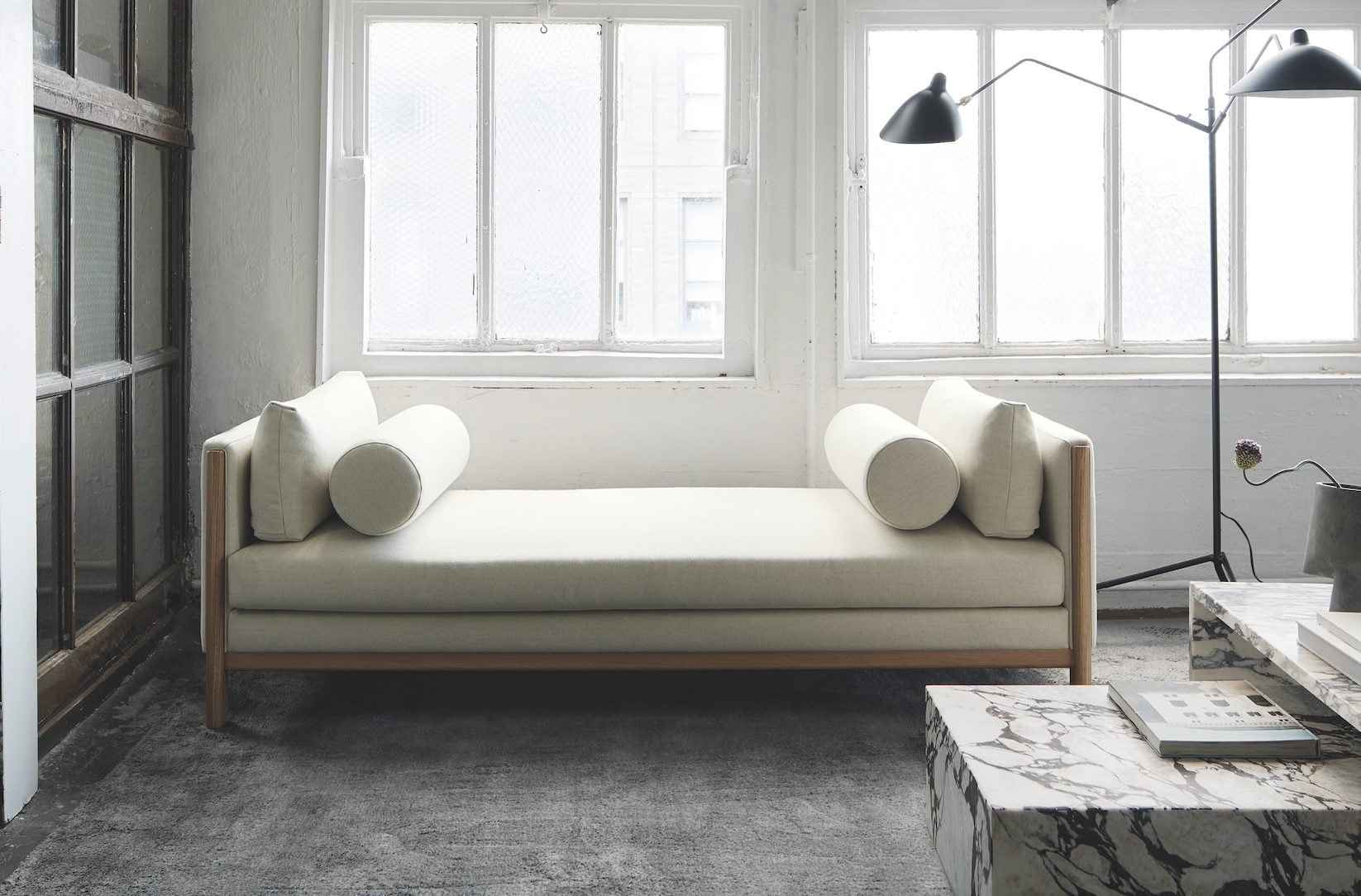
Emmy, Egg Collective
In designing the Emmy chaise, the Egg Collective trio of Stephanie Beamer, Crystal Ellis and Hillary Petrie, who met as students at Washington University in St. Louis, aimed for versatility. Indeed, the tailored chaise looks equally at home in a glass skyscraper as it does in a turn-of-the-century town house. Combining the elegance of a smooth, solid oak or walnut frame with the comfort of bolsters and cushioned upholstery or leather, it works just as well against a wall or at the heart of a room. From around $7,015; Eggcollective.com
 Plum, Michael Robbins
Plum, Michael Robbins
Woodworker Michael Robbins is the quintessential artisan from New York State’s Hudson Valley in that both his materials and methods pay homage to the area. In fact, he describes his style as “honest, playful, elegant and reflective of the aesthetic of the Hudson Valley surroundings”. Robbins crafts his furniture by hand but allows the wood he uses to help guide the look of a piece. (The studio offers eight standard finishes.) The Plum daybed, brought to life at Robbins’s workshop, exhibits his signature modern rusticity injected with a hint of whimsy thanks to the simplicity of its geometric forms. Around $4,275; MichaelRobbins.com

Kimani, Reda Amalou Design
French architect and designer Reda Amalou acknowledges the challenge of creating standout seating given the number of iconic 20th-century examples already in existence. Still, he persists—and prevails. The Kimani, a bent slash of a daybed in a limited edition of eight pieces, makes a forceful statement. Its leather cushion features a rolled headrest and rhythmic channel stitching reminiscent of that found on the seats of ’70s cars; visually, these elements anchor the slender silhouette atop a patinated bronze base with a sure-handed single line. The result: a seamless contour for the body. Around $33,530; RedaAmalou
Dune, Workshop/APD
From a firm known for crafting subtle but luxurious architecture and interiors, Workshop/APD’s debut furniture collection is on point. Among its offerings is the leather-wrapped Dune daybed. With classical and Art Deco influences, its cylindrical bolsters are a tactile celebration, and the peek of the curved satin-brass base makes for a sensual surprise. Associate principal Andrew Kline notes that the daybed adeptly bridges two seating areas in a roomy living space or can sit, bench-style, at the foot of a bed. From $13,040; Workshop/ APD
Sherazade, Edra
Designed by Francesco Binfaré, this sculptural, minimalist daybed—inspired by the rugs used by Eastern civilizations—allows for complete relaxation. Strength combined with comfort is the name of the game here. The Sherazade’s structure is made from light but sturdy honeycomb wood, while next-gen Gellyfoam and synthetic wadding aid repose. True to Edra’s amorphous design codes, it can switch configurations depending on the user’s mood or needs; for example, the accompanying extra pillows—one rectangular and one cylinder shaped— interchange to become armrests or backrests. From $32,900; Edra
You may also like.
By Josh Bozin
24/07/2024
22/07/2024
Watches & Wonders 2024 Showcase: Hermès
We head to Geneva for the Watches & Wonders exhibition; a week-long horological blockbuster featuring the hottest new drops, and no shortage of hype.
With Watches & Wonders 2024 well and truly behind us, we review some of the novelties Hermès presented at this year’s event.
—
HERMÈS

Moving away from the block colours and sporty aesthetic that has defined Hermès watches in recent years, the biggest news from the French luxury goods company at Watches & Wonders came with the unveiling of its newest collection, the Hermès Cut.
It flaunts a round bezel, but the case middle is nearer to a tonneau shape—a relatively simple design that, despite attracting flak from some watch aficionados, works. While marketed as a “women’s watch”, the Cut has universal appeal thanks to its elegant package and proportions. It moves away from the Maison’s penchant for a style-first product; it’s a watch that tells the time, not a fashion accessory with the ability to tell the time.
Hermès gets the proportions just right thanks to a satin-brushed and polished 36 mm case, PVD-treated Arabic numerals, and clean-cut edges that further accentuate its character. One of the key design elements is the positioning of the crown, boldly sitting at half-past one and embellished with a lacquered or engraved “H”, clearly stamping its originality. The watch is powered by a Hermès Manufacture movement H1912, revealed through its sapphire crystal caseback. In addition to its seamlessly integrated and easy-wearing metal bracelet, the Cut also comes with the option for a range of coloured rubber straps. Together with its clever interchangeable system, it’s a cinch to swap out its look.
It will be interesting to see how the Hermès Cut fares in coming months, particularly as it tries to establish its own identity separate from the more aggressive, but widely popular, Ho8 collection. Either way, the company is now a serious part of the dialogue around the concept of time.
—
Read more about this year’s Watches & Wonders exhibition at robbreport.com.au
You may also like.
22/07/2024
Living La Vida Lagerfeld
The world remembers him for fashion. But as a new tome reveals, the iconoclastic designer is defined as much by extravagant, often fantastical, homes as he is clothes.
“Lives, like novels, are made up of chapters”, the world-renowned bibliophile, Karl Lagerfeld, once observed.
Were a psychological-style novel ever to be written about Karl Lagerfeld’s life, it would no doubt give less narrative weight to the story of his reinvigoration of staid fashion houses like Chloe, Fendi and Chanel than to the underpinning leitmotif of the designer’s constant reinvention of himself.
In a lifetime spanning two centuries, Lagerfeld made and dropped an ever-changing parade of close friends, muses, collaborators and ambiguous lovers, as easily as he changed his clothes, his furniture… even his body. Each chapter of this book would be set against the backdrop of one of his series of apartments, houses and villas, whose often wildly divergent but always ultra-luxurious décor reflected the ever-evolving personas of this compulsively public but ultimately enigmatic man.
With the publication of Karl Lagerfeld: A Life in Houses these wildly disparate but always exquisite interiors are presented for the first time together as a chronological body of work. The book indeed serves as a kind of visual novel, documenting the domestic dreamscapes in which the iconic designer played out his many lives, while also making a strong case that Lagerfeld’s impact on contemporary interior design is just as important, if not more so, than his influence on fashion.
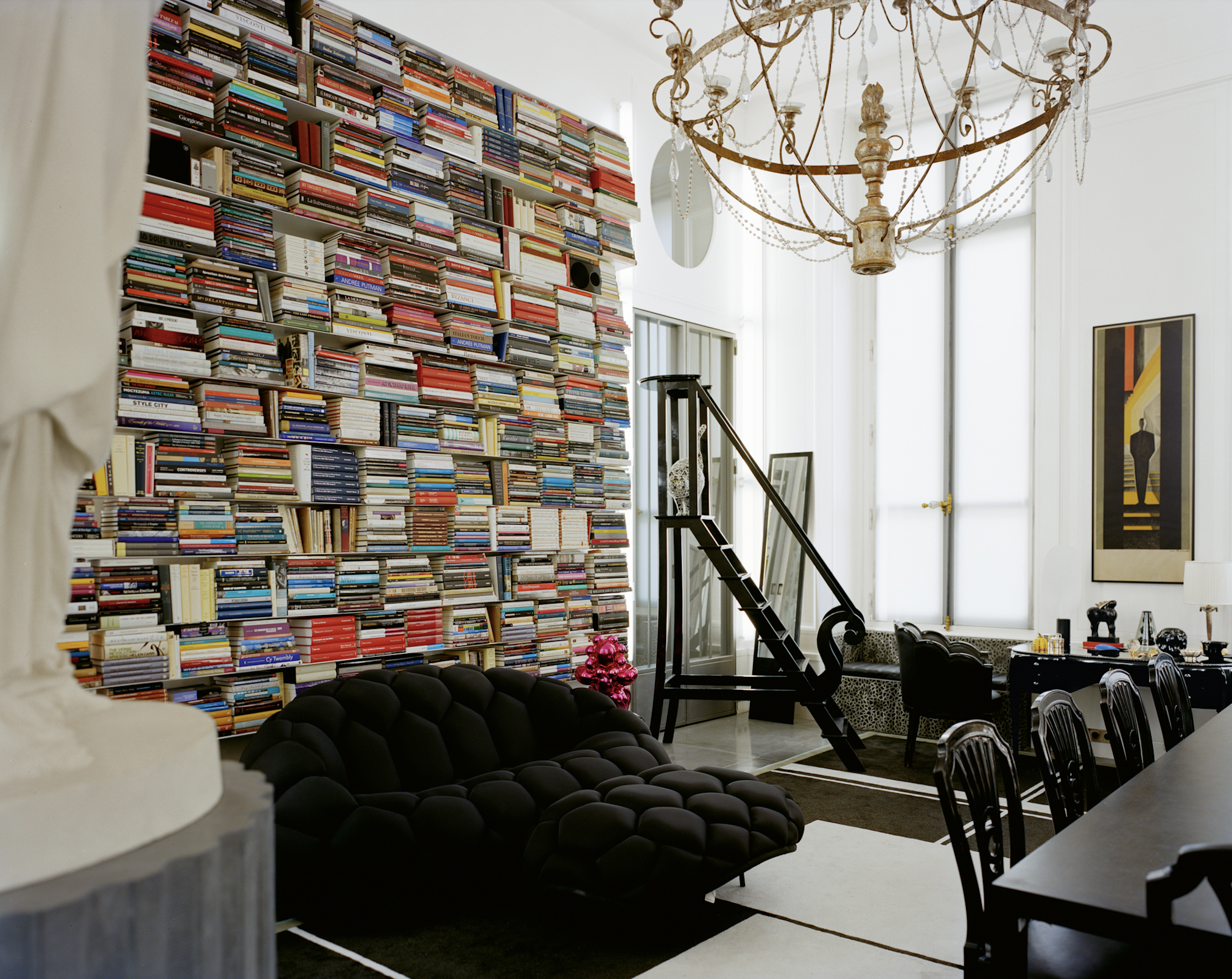
In fact, when the first Lagerfeld interior was featured in a 1968 spread for L’OEil magazine, the editorial describes him merely as a “stylist”. The photographs of the apartment in an 18th-century mansion on rue de Université, show walls lined with plum-coloured rice paper, or lacquered deepest chocolate brown in sharp contrast to crisp, white low ceilings that accentuated the horizontality that was fashionable among the extremely fashionable at the time. Yet amid this setting of aggressively au courant modernism, the anachronistic pops of Art Nouveau and Art Deco objects foreshadow the young Karl’s innate gift for creating strikingly original environments whose harmony is achieved through the deft interplay of contrasting styles and contexts.
Lagerfeld learned early on that presenting himself in a succession of gem-like domestic settings was good for crafting his image. But Lagerfeld’s houses not only provided him with publicity, they also gave him an excuse to indulge in his greatest passion. Shopping!
By 1973, Lagerfeld was living in a new apartment at Place Saint–Sulpice where his acquisition of important Art Deco treasures continued unabated. Now a bearded and muscular disco dandy, he could most often be found in the louche company of the models, starlets and assorted hedonistic beauties that gathered around the flamboyant fashion illustrator Antonio Lopez. Lagerfeld was also in the throes of a hopeless love affair with Jacques de Bascher whose favours he reluctantly shared with his nemesis Yves Saint Laurent.
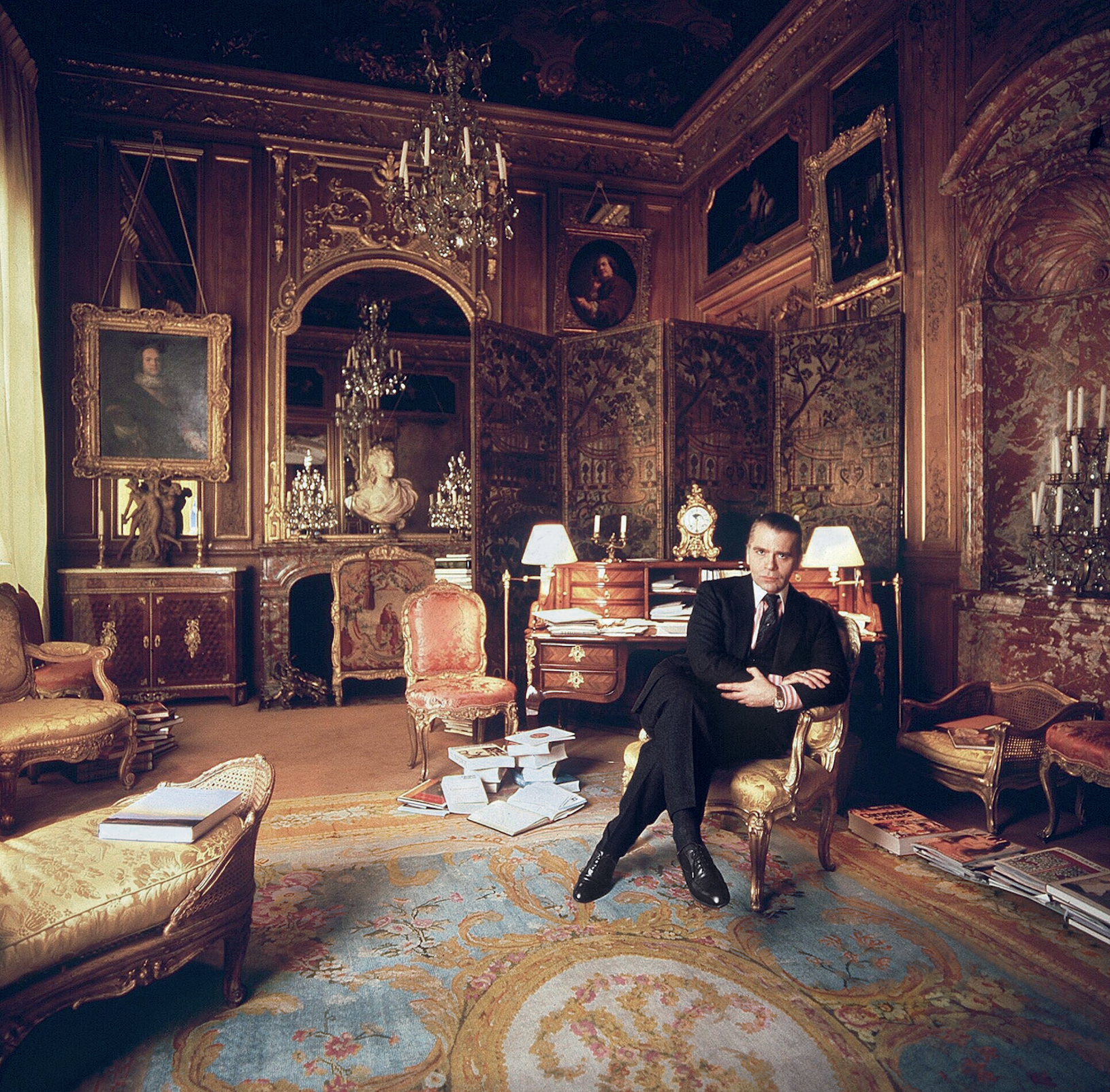
He painted the rooms milky white and lined them with specially commissioned carpets—the tawny patterned striations of which invoked musky wild animal pelts. These lent a stark relief to the sleek, machine-age chrome lines of his Deco furnishings. To contemporary eyes it remains a strikingly original arrangement that subtly conveys the tensions at play in Lagerfeld’s own life: the cocaine fuelled orgies of his lover and friends, hosted in the pristine home of a man who claimed that “a bed is for one person”.
In 1975, a painful falling out with his beloved Jacques, who was descending into the abyss of addiction, saw almost his entire collection of peerless Art Deco furniture, paintings and objects put under the auctioneer’s hammer. This was the first of many auction sales, as he habitually shed the contents of his houses along with whatever incarnation of himself had lived there. Lagerfeld was dispassionate about parting with these precious goods. “It’s collecting that’s fun, not owning,” he said. And the reality for a collector on such a Renaissance scale, is that to continue buying, Lagerfeld had to sell.
Of all his residences, it was the 1977 purchase of Hôtel Pozzo di Borgo, a grand and beautifully preserved 18th-century house, that would finally allow him to fulfill his childhood fantasies of life in the court of Madame de Pompadour. And it was in this aura of Rococó splendour that the fashion designer began to affect, along with his tailored three-piece suits, a courtier’s ponytailed and powdered coif and a coquettish antique fan: marking the beginning of his transformation into a living, breathing global brand that even those with little interest in fashion would immediately recognise.
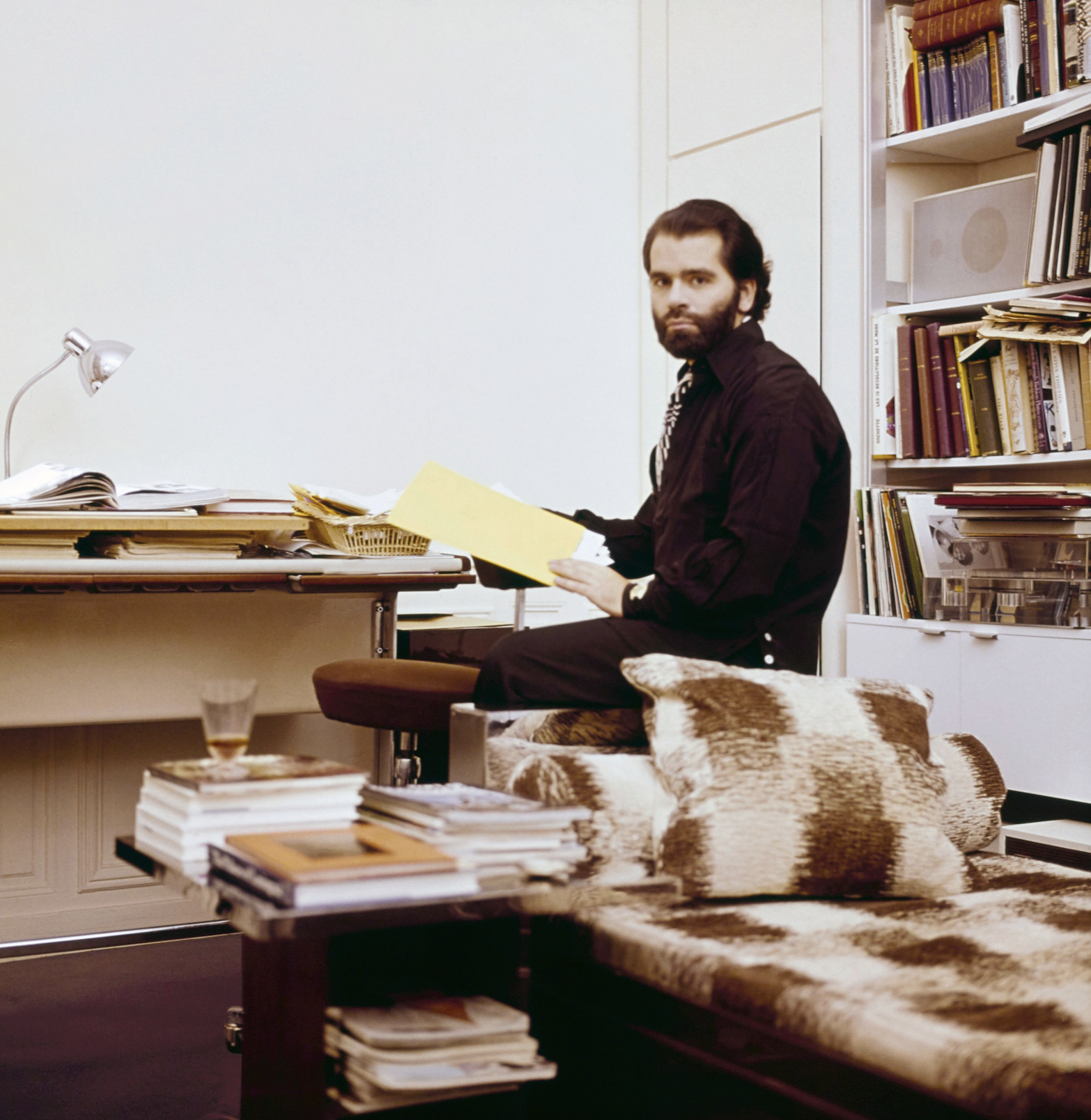
Lagerfeld’s increasing fame and financial success allowed him to indulge in an unprecedented spending frenzy, competing with deep-pocketed institutions like the Louvre to acquire the finest, most pedigreed pearls of the era—voluptuously carved and gilded bergères; ormolu chests; and fleshy, pastel-tinged Fragonard idylls—to adorn his urban palace. His one-time friend André Leon Talley described him in a contemporary article as suffering from “Versailles complex”.
However, in mid-1981, and in response to the election of left-wing president, François Mitterrand, Lagerfeld, with the assistance of his close friend Princess Caroline, became a resident of the tax haven of Monaco. He purchased two apartments on the 21st floor of Le Roccabella, a luxury residential block designed by Gio Ponti. One, in which he kept Jacques de Bascher, with whom he was now reconciled, was decorated in the strict, monochromatic Viennese Secessionist style that had long underpinned his aesthetic vocabulary; the other space, though, was something else entirely, cementing his notoriety as an iconoclastic tastemaker.

Lagerfeld had recently discovered the radically quirky designs of the Memphis Group led by Ettore Sottsass, and bought the collective’s entire first collection and had it shipped to Monaco. In a space with no right angles, these chaotically colourful, geometrically askew pieces—centred on Masanori Umeda’s famous boxing ring—gave visitors the disorientating sensation of having entered a corporeal comic strip. By 1991, the novelty of this jarring postmodern playhouse had inevitably worn thin and once again he sent it all to auction, later telling a journalist that “after a few years it was like living in an old Courrèges. Ha!”

In 1989, de Bascher died of an AIDS-related illness, and while Lagerfeld’s career continued to flourish, emotionally the famously stoic designer was struggling. In 2000, a somewhat corpulent Lagerfeld officially ended his “let them eat cake” years at the Hôtel Pozzo di Borgo, selling its sumptuous antique fittings in a massive headline auction that stretched over three days. As always there were other houses, but now with his longtime companion dead, and his celebrity metastasising making him a target for the paparazzi, he began to look less for exhibition spaces and more for private sanctuaries where he could pursue his endless, often lonely, work.
His next significant house was Villa Jako, named for his lost companion and built in the 1920s in a nouveau riche area of Hamburg close to where he grew up. Lagerfeld shot the advertising campaign for Lagerfeld Jako there—a fragrance created in memorial to de Bascher. The house featured a collection of mainly Scandinavian antiques, marking the aesthetic cusp between Art Nouveau and Art Deco. One of its rooms Lagerfeld decorated based on his remembrances of his childhood nursery. Here, he locked himself away to work—tellingly—on a series of illustrations for the fairy tale, The Emperor’s New Clothes. Villa Jako was a house of deep nostalgia and mourning.
But there were more acts—and more houses—to come in Lagerfeld’s life yet. In November 2000, upon seeing the attenuated tailoring of Hedi Slimane, then head of menswear at Christian Dior, the 135 kg Lagerfeld embarked on a strict dietary regime. Over the next 13 months, he melted into a shadow of his former self. It is this incarnation of Lagerfeld—high white starched collars; Slimane’s skintight suits, and fingerless leather gloves revealing hands bedecked with heavy silver rings—that is immediately recognisable some five years after his death.
The 200-year-old apartment in Quái Voltaire, Paris, was purchased in 2006, and after years of slumber Lagerfeld—a newly awakened Hip Van Winkle—was ready to remake it into his last modernist masterpiece. He designed a unique daylight simulation system that meant the monochromatic space was completely without shadows—and without memory. The walls were frosted and smoked glass, the floors concrete and silicone; and any hint of texture was banned with only shiny, sleek pieces by Marc Newson, Martin Szekely and the Bouroullec Brothers permitted. Few guests were allowed into this monastic environment where Lagerfeld worked, drank endless cans of Diet Coke and communed with Choupette, his beloved Birman cat, and parts of his collection of 300,000 books—one of the largest private collections in the world.

Lagerfeld died in 2019, and the process of dispersing his worldly goods is still ongoing. The Quái Voltaire apartment was sold this year for US$10.8 million (around $16.3 million). Now only the rue de Saint-Peres property remains within the Lagerfeld trust. Purchased after Quái Voltaire to further accommodate more of his books—35,000 were displayed in his studio alone, always stacked horizontally so he could read the titles without straining his neck—and as a place for food preparation as he loathed his primary living space having any trace of cooking smells. Today, the rue de Saint-Peres residence is open to the public as an arts performance space and most fittingly, a library.
You may also like.
By Josh Bozin
24/07/2024
Watch This Space: Mike Nouveau
Meet the game-changing horological influencers blazing a trail across social media—and doing things their own way.
In the thriving world of luxury watches, few people own a space that offers unfiltered digital amplification. And that’s precisely what makes the likes of Brynn Wallner, Teddy Baldassarre, Mike Nouveau and Justin Hast so compelling.
These thought-provoking digital crusaders are now paving the way for the story of watches to be told, and shown, in a new light. Speaking to thousands of followers on the daily—mainly via TikTok, Instagram and YouTube—these progressive commentators represent the new guard of watch pundits. And they’re swaying the opinions, and dollars, of the up-and-coming generations who now represent the target consumer of this booming sector.
—
MIKE NOUVEAU
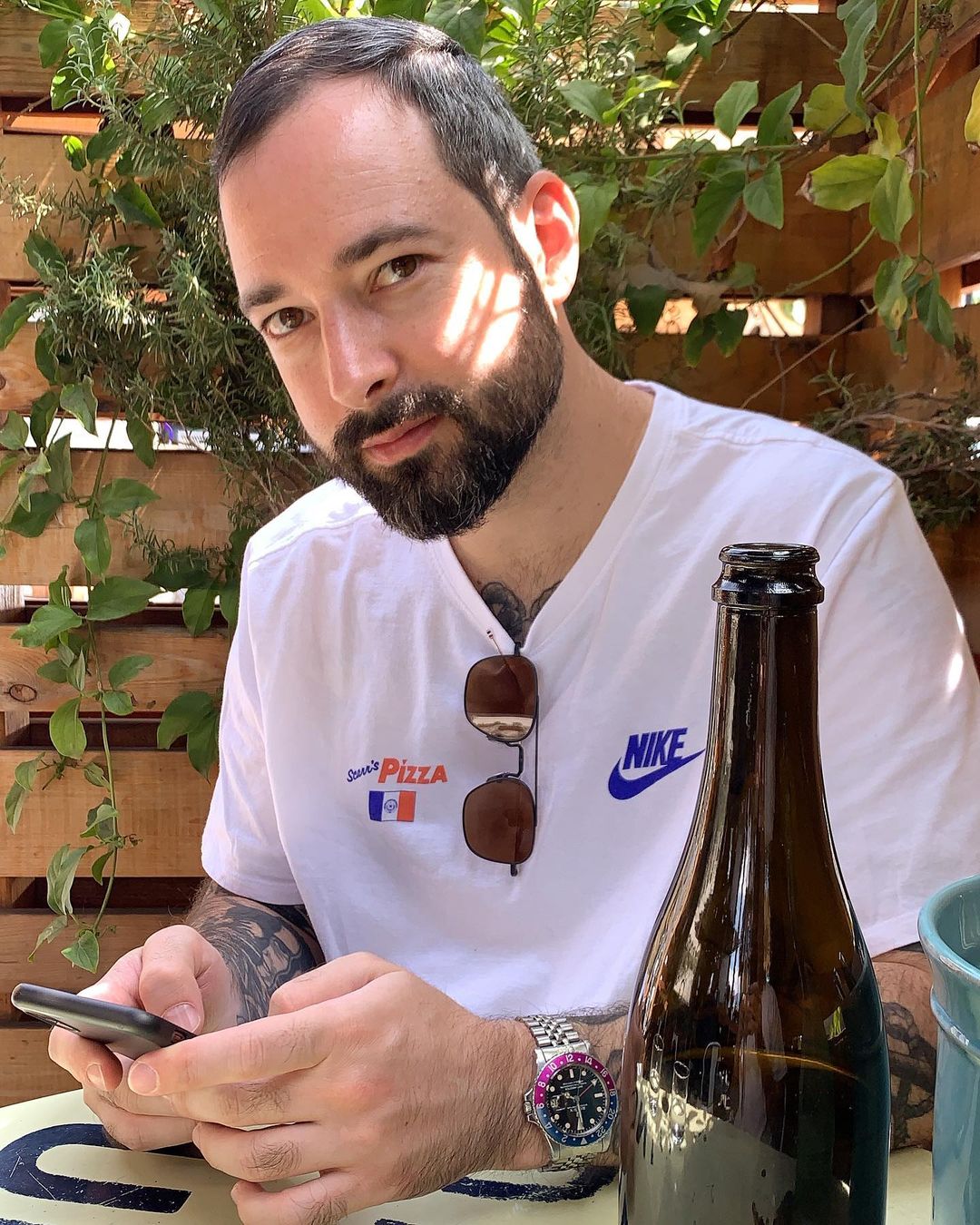
Can we please see what’s on the wrist? That’s the question that catapulted Mike Nouveau into watch stardom, thanks to his penchant for highlighting incredibly rare timepieces across his TikTok account of more than 400,000 followers. When viewing Nouveau’s attention-grabbing video clips—usually shot in a New York City neighbourhood—it’s not uncommon to find him wrist-rolling some of the world’s rarest timepieces, like the million-dollar Cartier Cheich (a clip he posted in May).
But how did someone without any previous watch experience come to amass such a cult following, and in the process gain access to some of the world’s most coveted timepieces? Nouveau admits had been a collector for many years, but moved didn’t move into horology full-time until 2020, when he swapped his DJing career for one as a vintage watch specialist.
“I probably researched for a year before I even bought my first watch,” says Nouveau, alluding to his Rolex GMT Master “Pepsi” ref. 1675 from 1967, a lionised timepiece in the vintage cosmos. “I would see deals arise that I knew were very good, but they weren’t necessarily watches that I wanted to buy myself. I eventually started buying and selling, flipping just for fun because I knew how to spot a good deal.”
Nouveau claims that before launching his TikTok account in the wake of Covid-19, no one in the watch community knew he existed. “There really wasn’t much watch content, if any, on TikTok before I started posting, especially talking about vintage watches. There’s still not that many voices for vintage watches, period,” says Nouveau. “It just so happens that my audience probably skews younger, and I’d say there are just as many young people interested in vintage watches as there are in modern watches.”
View this post on Instagram
Nouveau recently posted a video to his TikTok account revealing that the average price of a watch purchased by Gen Z is now almost US$11,000 (around $16,500), with 41 percent of them coming into possession of a luxury watch in the past 12 months.
“Do as much independent research as you can [when buying],” he advises. “The more you do, the more informed you are and the less likely you are to make a mistake. And don’t bring modern watch expectations to the vintage world because it’s very different. People say, ‘buy the dealer’, but I don’t do that. I trust myself and myself only.”
—
Read more about the influencers shaking up horology here with Justin Hast, Brynn Wallner and Teddy Baldassare.
You may also like.
By Josh Bozin
24/07/2024
This Pristine 1960 Ferrari 250 Spider Could Fetch $24 Million at Auction
The car wears the same colours and has the same engine it left the factory with.
Some Ferraris are just a little bit more important than others.
Take, for example, the 1960 250 GT SWB California that RM Sotheby’s is auctioning off during this year’s Monterey Car Week. Any example of the open-top beauty would attract interest, but this one just so happens to be the first one that was built.
The 250 is one of the most legendary series of cars in Ferrari history. Between 1952 and 1964, the company released 21 different 250 models—seven for racetracks, 14 for public roads—of which the “Cali Spider” might be the most well regarded, thanks to its potent V-12 and a Pininfarina-penned design that is one of the most beautiful bodies to grace an automobile. The roadster, which was specifically built for the U.S., made its debut in 1957 as a long-wheel-base model (LWB), but it wasn’t until the SWB model debut in 1960 that it became clear how special it was. This example isn’t just the first to roll off the line. It’s the actual car that was used to introduce the world to the model at the 1960 Geneva Motor Show.

Just 56 examples of the 250 GT SWB California Spider would be built by Scaglietti during the three years it was in production. The first of those, chassis 1795 GT, is finished in a glossy coat of Grigio. The two-door had a red leather interior at Geneva but was returned to the factory and re-outfitted with black leather upholstery before being delivered to its original owner, British race car driver John Gordon Bennet. Six-and-a-half decades later the car looks identical to how it did when it left the factory the second time.
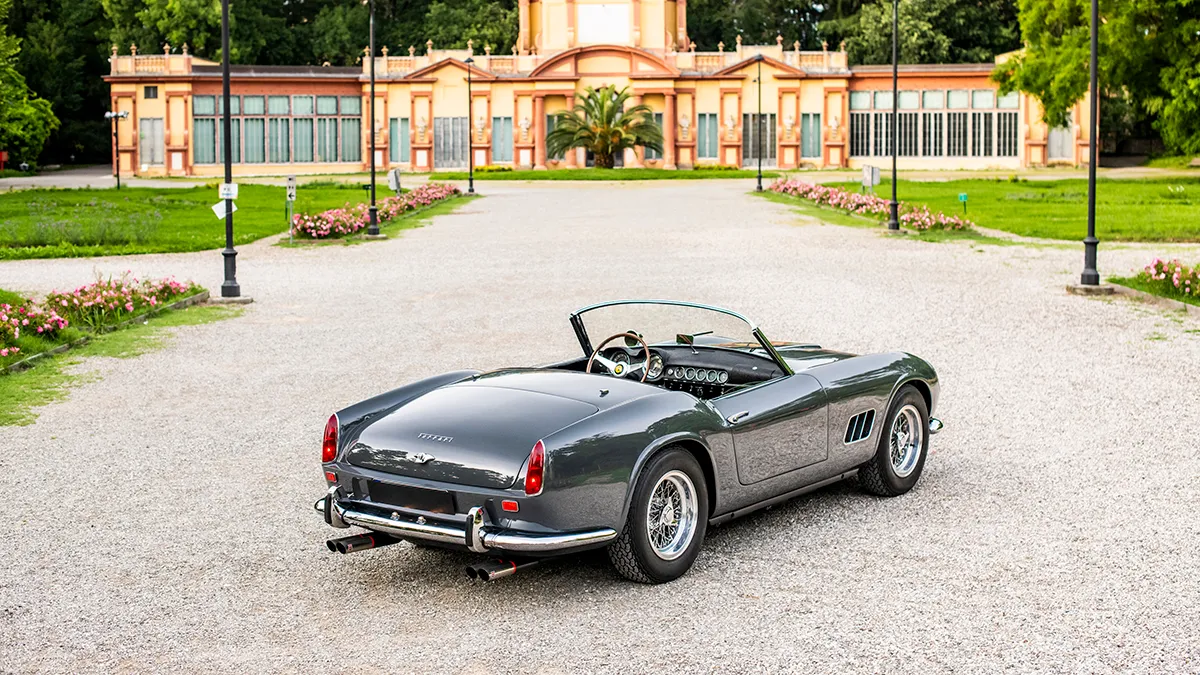
In addition to its original bodywork, the chassis 1795 GT features its original engine, gearbox, and rear axle. That mill is the competition-spec Tipo 168, a 3.0-litre V-12 that makes 196.1 kW. That may not sound like much by today’s standards, but, when you consider that the 250 GT SWB California Spider tips the scales around 952 kilograms, it’s more than enough.
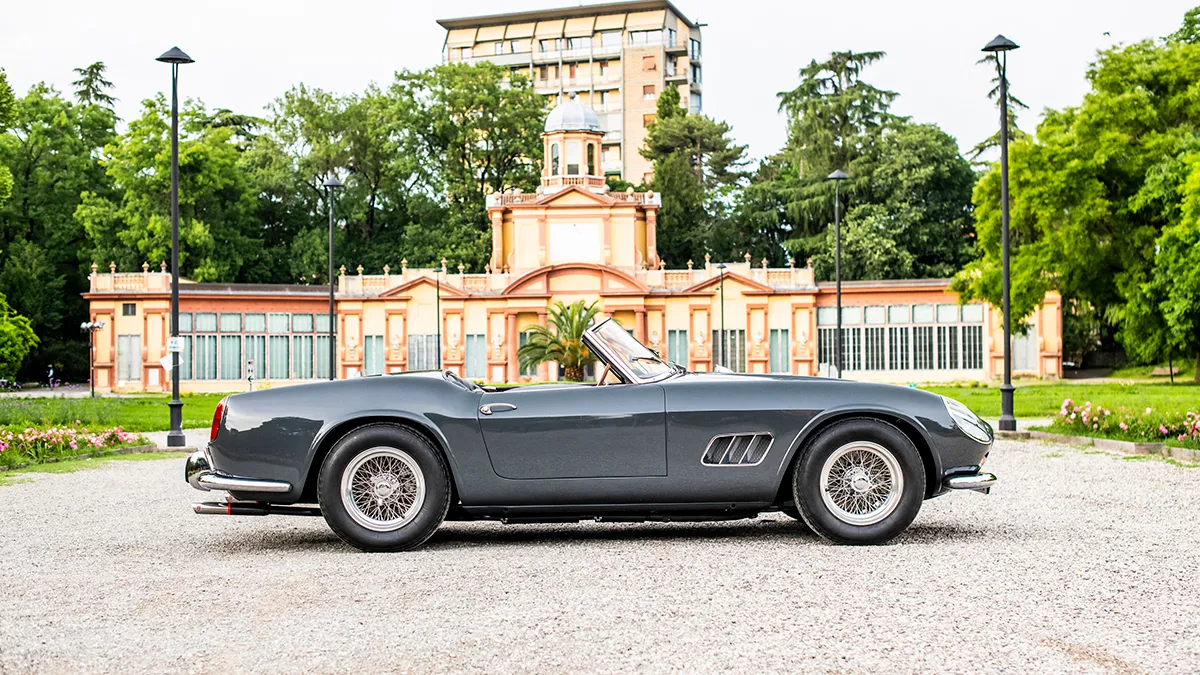
The first 250 GT SWB California Spider is scheduled to go up for bid during RM Sotheby’s annual Monterey Car Week auction, which runs from Thursday, August 15, to Saturday, August 17. Unsurprisingly, the house has quite high hopes for the car. The car carries an estimate of between $24 million and $26 million, which could make it one of the most expensive cars ever sold at auction.
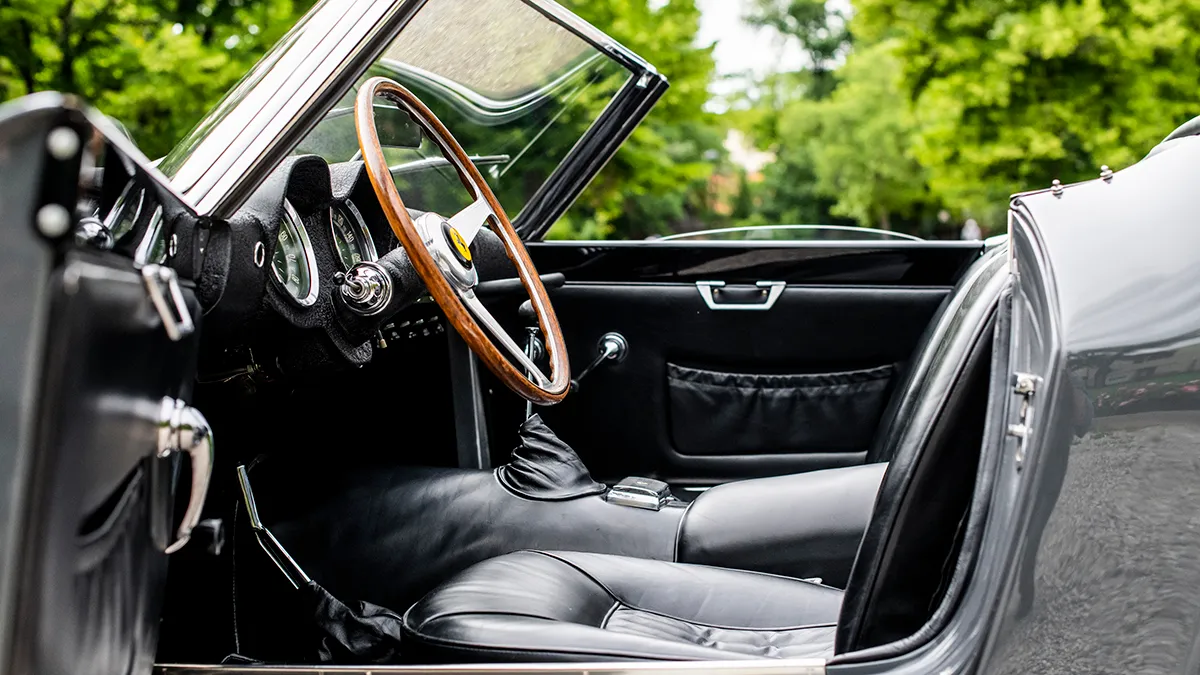
You may also like.
By Josh Bozin
24/07/2024






